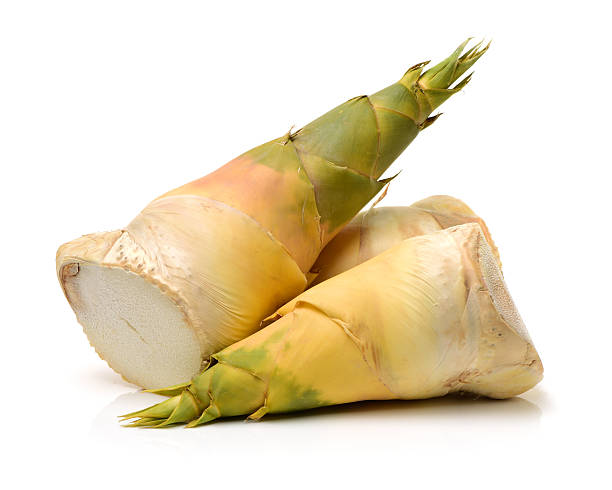

Bambusa vulgaris Schrad. ex J.C.Wendl.
|
It is commonly known as Baans and also referred as "green gold" of India. It belongs to the family Poaceae. Young shoots of the plant are cooked or pickled which helps to stimulate the appetite, prevent constipation, and improve digestion. Fermented bamboo shoot houses a number of beneficial microorganisms that imparts uncountable health benefits like anti-cancer, anti-oxidant, probiotics etc. Fermented bamboo shoots are cooked with legumes, other vegetables and non-veg items by tribal communities in North-Eastern states of the country. Bamboo salt reduced the increased levels of IgE, histamine, and IL-1β in serum indicating its immune boosting property. Mode of Consumption : Fermented, cooked, pickled |
| Plant Details | Agro-climatic Zone | Vernacular Names | Pictures |
| Scientific Name: Bambusa vulgaris Schrad. ex J.C.Wendl. Family: Poaceae Barnhart Class: Magnoliopsida Order: Poales Genus: Bambusa Schreb. Fruiting Season: June to September Parts: Young Shoots |
|
Andhra Pradesh : Karmaramu, Veduru Assam : Bah, Jati Bash Goa : Vaaso, Vaso Gujarat : Vaans, Baambu Jammu & Kashmir : Bains, Bons, Vanshah Karnataka : Vamsha Kerala : Manjamula Maharashtra : Baamboo, Kalaka, Kalanka, Velu Manipur : Wa Punjab : Banjh, Baans Tamil Nadu : Nama-tari, Vellai-munkil West Bengal : Baansha |
 Young shoots |
| Compound/Extract | Activity | Mode of Action | Marker/References |
| Bamboo salt | Anti-inflammatory | Bamboo salt reduced the increased levels of IgE, histamine, and IL-1β in serum. | IgE and IL-1β[1] |
| Bamboo salt | Anti-inflammatory | In spleen tissue of bamboo salt (BS)-treated mice, the levels of IFN-γ was increased, whereas the level of IL-4 was reduced. BS significantly inhibited the production of IL-1β and thymic stromal lymphopoietin and activation of caspase-1 in activated human mast cells. | IFN-γ, IL-4, IL-1β, and Caspase-1[1] |
| Bamboo salt | Anticancer | Sambou bamboo salt enhanced levels of immune-enhancing mediators, IFN-γ, IL-2, IL-6, IL-12, TNF‑α, and IgE in serum and melanoma tissues. It also enhanced activities of caspases and levels of Bax and p53, whereas decreased levels of Bcl-2. | IFN-γ, IL-2, IL-6, IL-12, TNF‑α, IgE, Caspases, Bax, p53, and Bcl-2[3] |
| Bamboo salt | Immunoboosting | Bamboo salt increased the levels of TNF‑α via the activation of NF-κB.It also significantly reduced the immobility times in the forced swimming test (FST) in male ICR mice and increased the levels of IFN-γ, IL-2 in RAW264.7 cells. | TNF‑α, NF-κB, IFN-γ, and IL-2[4] |
| Bamboo powder | Antioxidant, Immunoboosting | Bamboo powder improved blood parameters and platelets, and IgG, IgA, and IFN-γ in pigs. | IgG, IgA, and IFN-γ[5] |
| Bamboo salt | Immunoboosting | Purple bamboo salt (1 mg/mL) increased IFN-γ and IL-2 level (p<0.05). It also inhibited the expression of TNF-α mRNA in HMC-1 cells. | IFN-γ, IL-2, and TNF-α[6] |
| Major Class | Metabolites (Content of bioactives: mg/100g Fresh Weight) |
| Alkaloid | Caffeine: [7] |
| Amino Acid | Alanine: 124 mg/100g, Arginine: 97 mg/100g, Aspartic acid: 425 mg/100g, Cystine: 22 mg/100g, Glutamic acid: 248 mg/100g, Glycine: 87 mg/100g, Histidine: 42 mg/100g, Isoleucine: 88 mg/100g, Leucine: 140 mg/100g, Lysine: 134 mg/100g, Methionine: 30 mg/100g, Phenylalanine: 90 mg/100g, Serine: 127 mg/100g, Threonine: 86 mg/100g, Tryptophan: 27 mg/100g, Tyrosine: , Valine: 106 mg/100g[7] |
| Carboxylic Acid | Proline: 219 mg/100g[7] |
| Carotenoid | Lycopene: , α-Carotene: , β-Cryptoxanthin: [7] |
| Phytosterol | Campesterol: , Stigmasterol: , β-sitosterol: [2] |
| Sterol | Cholesterol: , Ergosterol: [2] |
| Terpenoid | β-Carotene: 0.012 mg/100g[7] |
| Vitamin | Ascorbic acid: 4 mg/100g, Phylloquinone: , α-Tocopherol: [7] |
| Effect | Observation | DOI |
| Disease | Formulation | Reference | Author | TKDL |
| Information from Wealth of India | Reference |
|
CSIR(1948).The Wealth of India, Vol.-IIB (Revised Edition), P.36-37, New Delhi, India |
| 4.2, 4.2.1, 4.2.1.1, 4.2.1.3, 4.2.2, 4.2.2.2, 4.2.2.3, 4.2.2.4, 4.2.2.5, 4.2.2.6, 4.2.2.7, 4.2.2.7 |
| CSIR-North East Institute of Science and Technology, Jorhat-6, Assam, India
CSIR-Institute of Himalayan Bioresource Technology, Palampur-61,Himachal Pradesh, India |